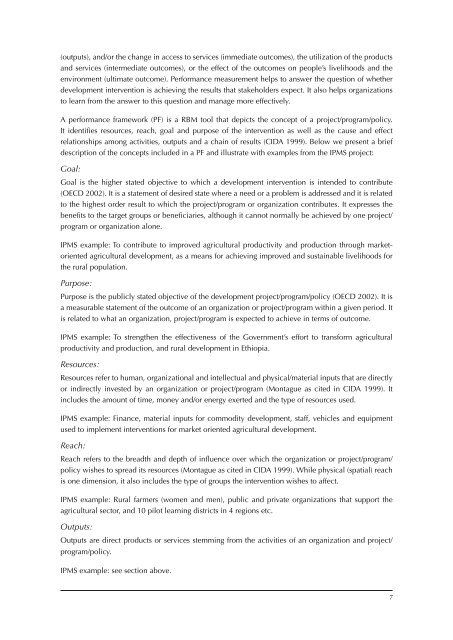A guide for practitioners
A guide for practitioners
A guide for practitioners
Create successful ePaper yourself
Turn your PDF publications into a flip-book with our unique Google optimized e-Paper software.
(outputs), and/or the change in access to services (immediate outcomes), the utilization of the productsand services (intermediate outcomes), or the effect of the outcomes on people’s livelihoods and theenvironment (ultimate outcome). Per<strong>for</strong>mance measurement helps to answer the question of whetherdevelopment intervention is achieving the results that stakeholders expect. It also helps organizationsto learn from the answer to this question and manage more effectively.A per<strong>for</strong>mance framework (PF) is a RBM tool that depicts the concept of a project/program/policy.It identifies resources, reach, goal and purpose of the intervention as well as the cause and effectrelationships among activities, outputs and a chain of results (CIDA 1999). Below we present a briefdescription of the concepts included in a PF and illustrate with examples from the IPMS project:Goal:Goal is the higher stated objective to which a development intervention is intended to contribute(OECD 2002). It is a statement of desired state where a need or a problem is addressed and it is relatedto the highest order result to which the project/program or organization contributes. It expresses thebenefits to the target groups or beneficiaries, although it cannot normally be achieved by one project/program or organization alone.IPMS example: To contribute to improved agricultural productivity and production through marketorientedagricultural development, as a means <strong>for</strong> achieving improved and sustainable livelihoods <strong>for</strong>the rural population.Purpose:Purpose is the publicly stated objective of the development project/program/policy (OECD 2002). It isa measurable statement of the outcome of an organization or project/program within a given period. Itis related to what an organization, project/program is expected to achieve in terms of outcome.IPMS example: To strengthen the effectiveness of the Government’s ef<strong>for</strong>t to trans<strong>for</strong>m agriculturalproductivity and production, and rural development in Ethiopia.Resources:Resources refer to human, organizational and intellectual and physical/material inputs that are directlyor indirectly invested by an organization or project/program (Montague as cited in CIDA 1999). Itincludes the amount of time, money and/or energy exerted and the type of resources used.IPMS example: Finance, material inputs <strong>for</strong> commodity development, staff, vehicles and equipmentused to implement interventions <strong>for</strong> market oriented agricultural development.Reach:Reach refers to the breadth and depth of influence over which the organization or project/program/policy wishes to spread its resources (Montague as cited in CIDA 1999). While physical (spatial) reachis one dimension, it also includes the type of groups the intervention wishes to affect.IPMS example: Rural farmers (women and men), public and private organizations that support theagricultural sector, and 10 pilot learning districts in 4 regions etc.Outputs:Outputs are direct products or services stemming from the activities of an organization and project/program/policy.IPMS example: see section above.7

















